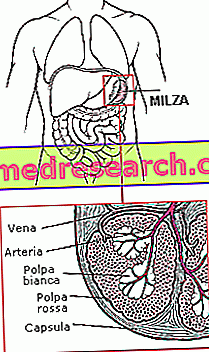Generality
The hyperbaric chamber is a physical place, present in hospitals and in the most modern medical clinics, in which an individual can breathe pure oxygen or oxygen-rich compressed air, at levels of pressure decidedly superior to those present in the ambient air.
To motivate the use of such high pressure inside the hyperbaric chambers is the fact that the latter guarantees greater accessibility to oxygen to the human organism.

The hyperbaric chamber treatment, better known as hyperbaric oxygen therapy, is indicated in various medical conditions; among the latter, they certainly deserve a quotation: decompression sickness, gas embolism, severe anemia, carbon monoxide poisoning, burns, compartment syndrome, brain abscess, gas gangrene and necrotizing infections.
The use of current hyperbaric chambers represents a safe medical practice and a low risk of complications.
What is the hyperbaric chamber?
The hyperbaric chamber is a physical place, present in the most well-equipped hospitals, where it is possible to breathe oxygen at pressure levels that are definitely higher than those present in the ambient air .
The use of the hyperbaric chamber for therapeutic reasons is one of the ways in which doctors can perform so-called oxygen therapy .
Oxygen therapy is the medical treatment that consists of the administration of a gaseous mixture with a high content of oxygen, by means of special dispensing devices.
According to the experts, oxygen therapy is a medical treatment, for example of a drug therapy, and oxygen is a medicine, just like aspirin, a NSAID etc.
Importance of oxygen
Oxygen is a fundamental gas for the survival of human beings and their well-being.
Circulating in the blood (to be precise in red blood cells), oxygen reaches all the cells of the body and provides them with the sustenance they need, to function at their best.
In addition, the protection against infection and the release of substances, such as growth factors and stem cells, that promote tissue healing processes depend on oxygen.
A lack of oxygen in the blood is a condition that affects the good health and proper functioning of the organs of the individual concerned.
Synonyms of hyperbaric camera
The hyperbaric chamber is also called decompression chamber or chamber for hyperbaric therapy .
Oxygen therapy performed by means of the hyperbaric chamber is more properly called hyperbaric oxygen therapy .
Indications
Candidates for hyperbaric chamber treatment are those who have reduced levels of oxygen in the blood and who, due to the condition they are suffering from, need an exogenous supply of oxygen (as they cannot remedy the deficiency on their own) .
The medical conditions for which the hyperbaric chamber indication is valid include:
- Decompression sickness;
- Gas embolism;
- Severe anemia;
- The brain abscess;
- Severe burns;
- The compartment syndrome;
- Injuries and crush injuries;
- Carbon monoxide poisoning;
- Gas gangrene;
- Infections of the skin or bones that cause tissue death (necrotizing infections);
- The presence of radiation wounds;
- Sudden deafness;
- Sudden and painless vision loss;
- The presence of wounds that do not heal (eg wounds due to diabetes).
Uncertain indications
Despite numerous studies on the subject, the therapeutic power of the hyperbaric chamber in the following medical conditions is still strongly in doubt:
- AIDS;
- Allergies;
- Alzheimer's disease;
- Arthritis;
- Asthma,
- Autism;
- Bell's palsy;
- Cancer;
- Cerebral palsy;
- Chronic fatigue syndrome;
- Cirrhosis;
- Fibromyalgia;
- Depression;
- Gastrointestinal ulcers;
- Heat stroke;
- Hepatitis;
- Migraine;
- Multiple sclerosis;
- Parkinson's disease;
- Spinal cord injury;
- Stroke.
Procedure
Normally, hyperbaric chamber treatments do not include hospitalization, except in cases where the condition that makes it necessary to use hyperbaric oxygen therapy is a disease worthy of other medical treatments.
Within a hyperbaric chamber, oxygen is administered in the presence of pressure levels which are 2-3 times higher than atmospheric pressure levels (ie ambient air). Using such pressure levels means that the human body is able to absorb more oxygen than it normally introduces when it is under noemal pressure conditions.
In other words, the high pressure, present inside a hyperbaric chamber, increases the availability of oxygen usable by the human body.
The entire performance of a hyperbaric chamber treatment - from the patient's housing to the ignition of the oxygen delivery machine and regulates the pressure - is under the control of a specialist doctor and highly qualified technical personnel, ready to intervene immediately in case of necessity.
Pure oxygen or compressed air?
Within a hyperbaric chamber, a patient can receive pure oxygen or oxygen-rich compressed air .
Although, from the therapeutic point of view, pure oxygen is more effective than compressed oxygen-rich air, the latter is preferred to the former, because it is less expensive and safer (see the chapter dedicated to the risks of the hyperbaric chamber).
Method of oxygen administration
The treatments in hyperbaric chamber based on pure oxygen require that the administration of the latter takes place by means of special helmets, masks or spray caps.
On the contrary, hyperbaric oxygen therapy based on compressed air foresees that the administration of oxygen takes place without the use of masks or alternative dispensing devices.
Duration
Generally, a single hyperbaric chamber treatment has a total duration of about 2 hours .
What does the patient feel in the hyperbaric chamber?
The most common sensation among those undergoing hyperbaric chamber treatment is the auricular fullness ; auricular fullness is the sensation that is typically experienced when you reach a high mountain place.
To remedy auricular fullness, it is sufficient to perform a sort of fake yawn and swallow
Types of hyperbaric chamber
There are two types of hyperbaric chamber: the single-seat hyperbaric chamber and the multiplace hyperbaric chamber .
HYPERBARIC SINGLE ROOM
The single-seat hyperbaric chamber is a cylinder of reduced dimensions, in transparent acrylic material (most of the cases) or in metal (rarely), which - as can be guessed from the name - has the capacity to accommodate only one patient at a time .
HYPERBARIC MULTIPOSED ROOM
Unlike the single-seat hyperbaric chamber, the multi-seat hyperbaric chamber is a large cylinder, made of metal, which has the ability to house more patients (and of course subject it to treatment) at a time.
In general, in addition to a compartment for the administration of oxygen (the so-called " treatment chamber "), the hyperbaric multiplace chamber also has a sort of antechamber, which is called " transfer chamber ".
Equipped with instruments for audio-visual communication with the inside of the treatment chamber, the transfer chamber is the place reserved for medical personnel who, during the hyperbaric oxygen therapy session, have the task of controlling the functioning of the hyperbaric chamber and helping patients entering or leaving the latter.
risks
Currently, the use of the hyperbaric chamber is a practice considered safe and at low risk of side effects and complications.
Complications of the hyperbaric chamber: what are they?
Side effects and complications, which can result from a hyperbaric chamber treatment, are a possible consequence of an excessive amount of taken / delivered oxygen or high pressure.
Among the possible side effects and possible complications of a session in the hyperbaric chamber are:
- Injuries and injuries of the middle ear (ex: rupture of the eardrum). The cause of these problems is high pressure.
- Temporary myopia . Occurs when oxygen is present in excessive amounts. Generally, vision returns to pre-treatment levels 3 weeks after hyperbaric oxygen therapy;
- Pulmonary barotrauma . A condition of pneumothorax may result from this condition;
- Epileptic crises . The cause is an excess of oxygen in the central nervous system;
- Brow pain or cheekbones .
- Inflammatory reactions . They are related to the fact that oxygen is a comburent and is highly flammable.
Preparation
Preparation for a hyperbaric chamber treatment is quite simple. The patient, in fact, must only pay attention to those precautionary measures, given in advance by the medical staff and aimed at minimizing the danger of fire, which is hidden behind the use of an effective comburent such as oxygen.
Going into the specifics of the aforementioned precautionary measures, the latter can be summarized essentially in two points:
- Avoid carrying lighters and any type of battery-operated device inside the hyperbaric chamber.
- On the day of the treatment, avoid applying to oil and scalp-based cosmetic hair. If the patient has no way of putting this precautionary measure into practice, the medical staff will remove the hair and cleanse the skin.
The table below shows, in brief, what a patient can do or not do, inside a hyperbaric chamber.
| Items allowed in the hyperbaric chamber: | Items prohibited in a hyperbaric chamber: | Other objects not allowed in the hyperbaric chamber: |
|
|
|
Contraindications
The hyperbaric chamber treatment has several contraindications; of these, some are of an absolute nature, others are of a relative nature.
Absolute contraindications to the hyperbaric chamber
Premise: an absolute contraindication is a condition in the presence of which the conditions for undertaking a specific medical action for diagnostic-therapeutic purposes are completely lacking.
Example to understand: the young age represents an absolute contraindication to the administration of aspirin (acetyl-salicylic acid), since the latter, in children and adolescents, is responsible for the so-called Reye's syndrome.
The hyperbaric chamber is absolutely contraindicated to:
- People with pneumothorax or severe COPD . In the above circumstances, hyperbaric oxygen therapy can induce the development of a potentially lethal medical condition, known as pneumothoracic tension.
- People who are following or have recently completed a drug therapy based on doxorubicin, cisplatin, disulfiram or mafenide. This is a temporary contraindication, in the sense that it is valid only for the entire duration of the assumptions and the first weeks following the end of the latter.
Contraindications related to the hyperbaric chamber
Premise: a relative contraindication is a condition in the presence of which a specific diagnostic or therapeutic action is inadvisable, unless there are more important circumstances, so the fact of refraining from the aforementioned action is more risky than intervening.
Example to understand: X-rays are contraindicated in case of pregnancy, unless a pregnant woman complains of serious disorders, whose causes are identifiable only with an X-ray.
Contraindications related to the hyperbaric chamber include: heart disease, high fever, pulmonary emphysema with carbon dioxide retention, a past history of thoracic surgery, the presence of a malignant tumor and barotraumatic otitis (or barotrauma of the middle ear).
What information do you tell the doctor?
The patient about to undergo a hyperbaric chamber treatment must absolutely notify the medical staff if:
- He is suffering from a cold, flu, fever, nasal congestion or chest congestion;
- She is pregnant or there are some chances that she is (obviously, in the event that the patient is a woman);
- Takes drugs or took medicines until a few days before;
- He missed the last meal before the hyperbaric chamber treatment;
- He took insulin (obviously, in the event a diabetes condition is present);
- He suffers from anxiety or has some concerns about the therapy he is about to face.
Results
The hyperbaric chamber is an effective therapeutic resource with good results.
However, it is necessary to specify that, in order to reap the benefits hoped for, more sessions are often necessary .
The precise number of sessions in the hyperbaric chamber depends on the health condition, which required the use of hyperbaric oxygen therapy.
For example, episodes of carbon monoxide poisoning usually involve a therapeutic cycle of 3 appointments, while cases of wounds that do not heal could also require 20 to 40 sessions.
Alone or in association with other treatments?
For some health conditions - specifically these are only decompression sickness, carbon monoxide poisoning and gas embolism - hyperbaric oxygen therapy is sufficient to achieve recovery; for other conditions, on the other hand, the use of the hyperbaric chamber must be associated with other treatments, so that the patient derives tangible benefits.



